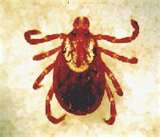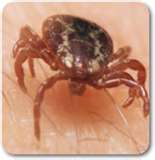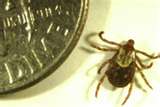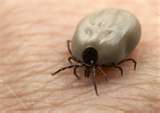- Home
- Pest Control
- Pest Identification
- This Page
Types of Fleas and Ticks
Do you have a flea and tick problem? If so, learn how to
get rid of fleas and ticks here. Fleas and ticks are pests that cause nuisance, irritation and disease carriers to animals and humans.
Fleas
With over 2,500 flea species worldwide, only a few species feed on cats and dogs with any regularity to be of any importance. The life cycle of a flea undergoes a complete metamorphosis with the life stages comprised of egg, larva, pupa and adult. From egg to adult can take from 3-4 weeks up to one year. The body has three sections: Head, thorax and abdomen. The body is covered with spines and bristles that project backwards, preventing it from being dislodged during grooming by the host.
Fleas are well known for their excellent jumping ability which results from the compression and subsequent release of energy from a natural rubber (resilin) pad in the hind legs.
Fleas, once on a host, will initiate feeding, sucking blood, within a few seconds and mating will occur within 24 hours. Female fleas begin egg production within 48 hours of taking their first blood meal and reach maximum production within nine days, and are capable of producing eggs for more than a hundred days. Daily flea egg production between 35 to 50 eggs is quite common and highly depended on the host animals grooming activities.
Fleas residing in cocoons, can remain dormant for up to one year, are stimulated to emerge and are immediately ready to respond to hosts activities. This stimuli is generated by the host causing vibrations by walking, closing doors, carbon dioxide, breathing and heat. Not all cocoons will hatch at the same time, only a small percentage will be triggered to hatch in any one location.
Over the centuries, fleas have been very well documented for the transmittal of disease. The most serious human disease was the bubonic plaque or the "Black Death" of the Middle Ages reportedly almost 1/3 of the known human population was killed. Another important disease transmitted by fleas is murine typhus. This disease occurs in humans and many small mammals.
Recommendation:
- If you have pets, it is highly recommended that you have your pets on two different flea treatment programs. Varying the treatment program from month to month. This will eliminate the flea tolerance on the treatment programs.
- If you become aware of a flea infestation within your home, constant vacuuming of all floor areas is recommended to generate the vibration stimuli required for the fleas to hatch. After each vacuuming, removal and discarding of the vacuum bag in outdoor trash is essential.
- If the flea infestation is overwhelming, please call Advantage Service, Inc. to solve this problem.
Cat Flea
The cat flea is the most important flea species because it attacks both cats and dogs.The adult flea inserts its mouthparts into the skin, injects saliva and sucks blood. The bite leaves a reddish spot on the skin. the saliva is irritating to the host, causing dermatitis and hair loss in allergic animals.
Female fleas within 48 hours of taking their blood meal, will be capable of producing 35-50 eggs daily for over 100 days.
Flea Life Cycle
The flea life cycle grows through three various stages before becoming an adult. From egg stage thru the pupa stage will only take approximately two to three weeks. During the pupa stage, the pupa can remain dormant for six to twelve months without a host.
Flea Egg Stage
The adult fleas lay white, shiny eggs on the host after acquiring a blood meal. The eggs are loosely laid on the host, so that they may fall off immediately into the pets or animals bedding areas. As the host is moving around, eggs will continue to drop in various locations. Female fleas can produce 35-50 eggs per day and eggs will hatch within ten days, depending on the temperature and humidity. Favorable environmental conditions are 70% relative humidity and above 65 degrees.
Flea Larva Stage
Flea larva will go through three stages within a two-week period. The larva will feed primarily on adult feces. Infested areas are normally found in the surrounding areas of where the pet or animal is resting either indoors or outdoors. Flea larvae are extremely susceptible to heat and desiccation. Relative humidities below 50% cause desiccation and failure to develop.
Flea Cocoon Stage
The flea larvae will pupate within the silken cocoons and change into the adult stage. Fleas can remain in the pupal stage within the cocoon for period up to one year without a host. Debris is incorporated within the cocoon and are difficult to locate. Within the cocoon, they are protected from insecticides and can resist chemical treatments. The pre-emerged adult flea will emerge from the cocoon upon proper stimulation, physical pressure, carbon dioxide, vibration and heat.
Ticks
With over 850 species worldwide, approximately 80 are found in the United States. The life cycle stage of a tick are the egg, larva, nymph and adult. Ticks are blood sucking ectoparasites of mammals, birds and reptiles. Ticks are classified as either hard bodied ticks or soft bodied ticks with mouth parts that project forward. The hard bodied tick feed on blood once for every life cycle stage and the soft bodied tick feed periodically during all of its life cycle stages. Ticks in general are creatures of woods and fields and would not be found in large numbers except for the brown dog tick.
The brown dog ticks' habitat is not only restricted to wooded areas and fields but to where domestic pests live. Pets do not acquire ticks from other pets, but pick up ticks from an infested residence, kennel, veterinarians office or similar places. An adult tick will crawl and attach itself around the ears and between the toes of the host. Once a female is engorged with a blood meal, which takes three to six days, will drop off from the host into cracks, crevices, carpeting and baseboards, and will lay from a few hundred eggs to over five thousand eggs. After the larvae emerges from the egg, they are capable of surviving for up to eight months without a meal. The larvae will lay and wait until a pet brushes by, and then crawls onto the host and commences feeding. After feeding, the larvae dops off and goes into hiding for up to four weeks. After this period of time, the nymphs molt and turn into adults.
Ticks are efficient vectors of a number of serious diseases of men and pets. Ticks in general run a close second to mosquitoes in the number of diseases transmitted to man. Typical viral diseases transmitted (vectored) by ticks include Colorado tick fever and Powassan encephalitis. Pathogenic bacteria transmitted by ticks include Lyme disease, relapsing fever and tularemia. tick borne rickettsia cause such human disease as Rocky Mountain spotted fever and endemic typhus. Ticks are capable of carrying and transmitting more than one pathogen to its host.
Recommendations:
- Avoid venturing into tick infested areas such as wooded and fielded areas.
- Wear long sleeves, long pants, boots and hats when venturing into tick infested areas.
- Light colored clothes are recommended to identify ticks.
- Tick repellents can be applied to the outside of clothing.
- Visual body inspection is advisable after venturing.
- Clothing should be washed immediately and never put clothing into the hamper with other clothes.
- Prevent pets from venturing into known tick infested areas.
- Remove all wood piles away from structures as far as possible.
Tick

Tick

Actual Size

Fully Engorged
